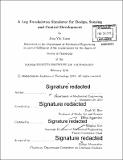| dc.contributor.advisor | Hugh M. Herr. | en_US |
| dc.contributor.author | Kuan, Jiun-Yih | en_US |
| dc.contributor.other | Massachusetts Institute of Technology. Department of Mechanical Engineering. | en_US |
| dc.date.accessioned | 2018-05-23T16:31:39Z | |
| dc.date.available | 2018-05-23T16:31:39Z | |
| dc.date.copyright | 2018 | en_US |
| dc.date.issued | 2018 | en_US |
| dc.identifier.uri | http://hdl.handle.net/1721.1/115717 | |
| dc.description | Thesis: Ph. D., Massachusetts Institute of Technology, Department of Mechanical Engineering, 2018. | en_US |
| dc.description | Cataloged from PDF version of thesis. | en_US |
| dc.description | Includes bibliographical references (pages 137-143). | en_US |
| dc.description.abstract | Leg exoskeletons have been developed in an effort to augment human locomotion for over a century. However, only two portable leg exoskeletal devices have shown a significant decrease in walking metabolism [35, 11], not to mention, no device that has shown effective assistance and biomimetic behavior across different walking speeds and terrains. This thesis aims to build a Leg Exoskeleton Simulator to effectively search the space of potential prosthetic and orthotic design, control, and sensing strategies so as to find the best means to improve human locomotion through wearable electromechanical technology and modern bionics, enabling rapid advancement of the human-machine interface. This thesis presents the MIT Exoskeleton Simulator, which is a modular tethered system that includes cable-drive mechanisms along with off-board power, actuation, control hardware, and wearable end-effector modules. In order to effectively transmit force to a wearable end-effector module, high-performance cable-drive modules with the Rolling Cable Transmission for both unidirectional actuation and bidirectional actuation were developed. A new Adaptive Coupling Joint design principle was proposed for designing a simple mechanical interface that can transmit pure torque from an input actuation source to any biological joint without altering the biological joint motions. The Simulator has been controlled with a bio-inspired control based controller that emulates the behavior of human morphology and neural control for the non-amputee participants. In this thesis, I tried to provide a base of knowledge regarding effective design, control, and sensing strategies for effective human augmentation. In the near future, more criteria can be further established for building effective leg exoskeletons that will improve the ambulatory speed, metabolic economy, and stability of walking humans. The Simulator could potentially enhance the ambulation of able-bodied persons or individuals with movement pathology, as well as providing the treatment or relief of gait dysfunction resulting from movement pathology, or restoration of age-related reduced locomotory function. | en_US |
| dc.description.statementofresponsibility | by Jiun-Yih Kuan. | en_US |
| dc.format.extent | 143 pages | en_US |
| dc.language.iso | eng | en_US |
| dc.publisher | Massachusetts Institute of Technology | en_US |
| dc.rights | MIT theses are protected by copyright. They may be viewed, downloaded, or printed from this source but further reproduction or distribution in any format is prohibited without written permission. | en_US |
| dc.rights.uri | http://dspace.mit.edu/handle/1721.1/7582 | en_US |
| dc.subject | Mechanical Engineering. | en_US |
| dc.title | A leg exoskeleton simulator for design, sensing and control development | en_US |
| dc.type | Thesis | en_US |
| dc.description.degree | Ph. D. | en_US |
| dc.contributor.department | Massachusetts Institute of Technology. Department of Mechanical Engineering | |
| dc.identifier.oclc | 1036986496 | en_US |
